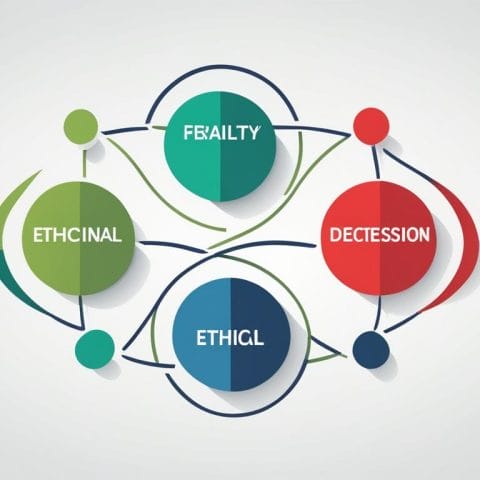Did you know that diversity training programs in the workplace have been proven to increase employee engagement, improve employee retention, and lead to positive systemic change? These programs have an incredible impact on company culture, fostering inclusivity and driving productivity.
In today’s diverse world, it is essential for organizations to prioritize diversity training in order to create a workplace that values and respects individuals from all walks of life. By implementing effective diversity training programs, companies can cultivate an inclusive environment that celebrates differences and promotes collaboration.
Key Takeaways:
- Diversity training programs in the workplace have a significant impact on company culture and can lead to positive systemic change.
- Engaged employees are more likely to stay with an organization, making diversity training crucial for employee retention.
- Diversity training can help improve hiring practices and increase diversity in leadership positions.
- Awareness training, skills-based diversity training, diversity audits, and basic diversity training are some of the types of diversity training programs available.
- Creating effective diversity training requires setting goals, providing resources, measuring progress, and fostering inclusive conversations.
Learn more about the different types of diversity training and how they can benefit your organization.
Importance of Diversity Training
Diversity training programs play a crucial role in fostering inclusivity and promoting employee engagement in the workplace. Studies have consistently shown that an engaged workforce outperforms a disengaged one, leading to increased productivity and overall organizational success. By implementing effective diversity training programs, companies can create an environment where employees from diverse backgrounds feel valued, respected, and empowered to contribute their unique perspectives and talents.
One of the key benefits of diversity training is its impact on employee retention. When individuals feel a sense of belonging and inclusivity within an organization, they are more likely to stay and thrive in their roles. A diverse and inclusive workplace culture promotes loyalty and reduces turnover rates.
In addition to enhancing employee engagement and retention, diversity training programs also drive positive systemic change within organizations. By addressing biases and stereotypes, diversity training helps improve hiring practices and creates opportunities for individuals from underrepresented groups to advance into leadership positions. This leads to more inclusive decision-making processes and a broader range of perspectives, ultimately driving innovation and growth.
It is important for organizations to invest in diversity training programs that are tailored to their specific needs and aligned with their overall goals. By creating a comprehensive and holistic approach to diversity training, organizations can ensure that employees at all levels are equipped with the knowledge and skills to promote inclusivity and challenge harmful stereotypes and biases.
“Diversity training is an essential tool for organizations to promote inclusivity, increase employee engagement, and drive positive systemic change.”
To measure the effectiveness of diversity training programs, organizations can establish clear goals and regularly assess progress. By consistently evaluating the impact of diversity training initiatives, organizations can identify areas for improvement and make necessary adjustments to ensure ongoing success.
In conclusion, diversity training programs are crucial for organizations seeking to create a more inclusive and equitable workplace culture. By prioritizing employee engagement, retention, and systemic change, companies can foster an environment where individuals from all backgrounds can thrive and contribute to their full potential.
Benefits of Diversity Training
| Benefits | Description |
|---|---|
| Increased Employee Engagement | Diversity training promotes a sense of belonging and fosters engagement among employees. |
| Improved Employee Retention | An inclusive workplace culture reduces turnover rates and fosters loyalty. |
| Positive Systemic Change | Diversity training improves hiring practices and increases diversity in leadership positions. |
| Enhanced Innovation and Growth | A diverse workforce with inclusive practices drives innovation and fosters organizational growth. |
Source: Diversity Training in the Workplace
Types of Diversity Training

Diversity training programs come in different types depending on the organization’s goals. These include awareness training, skills-based diversity training, diversity audits, and basic diversity training.
Awareness training is designed to increase understanding of workplace demographics and equity issues. It helps employees recognize and appreciate the diversity within their organization, promoting a culture of inclusivity.
Skills-based diversity training focuses on providing employees with practical skills and strategies for promoting inclusivity and overcoming bias. It equips individuals with the tools they need to create a more inclusive and respectful work environment.
Diversity audits assess colleague relationships and work environments to identify areas for improvement. These audits help organizations understand their current diversity and inclusion landscape and develop targeted strategies for positive change.
Basic diversity training is an essential foundation for creating respect and empathy in the workplace. It covers key concepts, such as understanding different identities, challenging stereotypes, and fostering a culture of inclusivity.
By offering various types of diversity training, organizations can address different aspects of diversity and inclusion, ensuring employees are equipped with the knowledge and skills needed to create a truly inclusive workplace culture.
Types of Diversity Training
| Type of Diversity Training | Description |
|---|---|
| Awareness Training | Increases understanding of workplace demographics and equity issues |
| Skills-based Diversity Training | Focuses on practical skills for promoting inclusivity and overcoming bias |
| Diversity Audits | Assesses colleague relationships and work environments to identify areas for improvement |
| Basic Diversity Training | Creates respect and empathy in the workplace through key foundational concepts |
Having a comprehensive diversity training approach that combines these different types can lead to a more inclusive and equitable work environment, where individuals from all backgrounds feel valued and supported.
Learn more about diversity training programs and how they can benefit your organization.
Effective Strategies for Creating Diversity Training
To ensure effective diversity training, organizations need to implement a strategic approach that considers their goals, resources, and progress measurement. By focusing on these key aspects, organizations can create impactful and inclusive training programs that lead to positive change.
Set Clear Goals and Communicate Them
One of the first steps in creating diversity training is to set clear and measurable goals. Organizations should determine what they want to achieve through their training program, whether it’s fostering inclusivity, promoting cultural awareness, or addressing unconscious bias. These goals should be communicated to employees to ensure everyone understands the purpose and benefits of the training.
Provide Adequate Resources
Creating effective diversity training requires providing employees with the necessary resources to engage and learn. This can include educational materials, workshops, guest speakers, or online courses. By investing in these resources, organizations show their commitment to diversity and provide employees with the tools they need to actively participate in the training program.
Measure Progress and Keep Employees Engaged
Regularly measuring progress is crucial for assessing the effectiveness of diversity training initiatives. Organizations should establish metrics or key performance indicators (KPIs) to track progress and identify areas for improvement. This can be done through surveys, feedback sessions, or pre- and post-training assessments. Continuous evaluation and feedback help keep employees engaged and demonstrate the organization’s commitment to ongoing development and improvement.
“Having clear goals and providing resources are essential in creating effective diversity training programs. By measuring progress and keeping employees engaged, organizations can drive positive changes in workplace culture.”
– Sarah Thompson, HR Director at XYZ Company
In addition to goal setting, resource allocation, and progress measurement, organizations should also be open to uncomfortable conversations during diversity training. It is important to create a safe space where employees can share their experiences, ask questions, and challenge existing perspectives. This inclusiveness ensures that all employees feel valued and heard, promoting a more inclusive and diverse workplace culture.
Creating diversity training programs that are effective and impactful requires a thoughtful and comprehensive approach. By setting clear goals, providing resources, measuring progress, and promoting inclusivity, organizations can create a training program that fosters diversity, equity, and inclusion in the workplace.
Diversity Training Topics
When it comes to diversity training, there are various essential topics that organizations should cover to foster an inclusive and equitable workplace culture. These topics address the diverse identities and experiences of employees, promoting understanding, empathy, and respect. By addressing these subjects, organizations can create an environment that values diversity and promotes inclusivity.
Diversity training topics encompass a wide range of areas. They include:
- Gender diversity: Understanding and embracing the experiences and challenges faced by individuals of different genders, including transgender and non-binary individuals.
- Generational diversity: Recognizing and appreciating the perspectives and strengths of various generations in the workplace, such as Baby Boomers, Gen X, Millennials, and Gen Z.
- Intentional inclusion: Creating intentional strategies and practices to foster an inclusive and welcoming environment for individuals of all backgrounds and identities.
- Microaggressions: Addressing the subtle but harmful insults and derogatory messages that individuals from marginalized groups may experience in the workplace.
- Diversity vs. inclusion: Understanding the difference between diversity and inclusion, and how both concepts contribute to workplace culture and success.
- Racism: Recognizing and addressing systemic racism to create a workplace environment that promotes equality and racial justice.
- Cultural diversity: Promoting an appreciation for different cultural backgrounds and traditions, fostering understanding and respect among employees.
- Stereotypes: Challenging biases and stereotypes that can negatively impact the experiences of individuals from diverse backgrounds.
- LGBTQ+ inclusion: Creating an inclusive and supportive environment for lesbian, gay, bisexual, transgender, and queer individuals, ensuring equal opportunities and eradicating discrimination.
- Unconscious bias: Raising awareness of unconscious biases that can affect decision-making and interpersonal interactions, and providing strategies for mitigating their impact.
By addressing these diversity training topics, organizations can create a workplace culture that values and embraces diversity, fostering an environment where every employee feels respected, included, and valued for their unique contributions.
Generational Diversity in the Workplace

Generational diversity plays a crucial role in today’s workforce, with employees from different age groups bringing unique perspectives, experiences, and skills to the table. Organizations that recognize and address generational diversity in their diversity training programs can foster better workplace communication, break down stereotypes, and increase productivity.
One of the key benefits of addressing generational diversity is the improvement in workplace communication. Each generation has its own communication styles, preferences, and expectations. For example, younger employees may prefer email or instant messaging, while older employees may prefer face-to-face or phone conversations. By understanding these differences and promoting effective communication strategies, organizations can bridge the generational gap and create a more collaborative and inclusive work environment.
Addressing generational stereotypes is another important aspect of diversity training. Stereotypes can create divisions and misunderstandings among employees, hindering collaboration and productivity. By educating employees about different generations and debunking stereotypes, organizations can foster a more inclusive and respectful workplace culture. This can lead to increased trust, better teamwork, and higher employee satisfaction, ultimately improving overall productivity.
Moreover, diversity training programs that address generational diversity can help organizations tap into the diverse range of skills and experiences that each generation brings. Younger employees may have a strong grasp of technology and innovation, while older employees may possess invaluable industry knowledge and wisdom. By fostering cross-generational collaboration and recognizing the value of each generation’s contributions, organizations can harness the full potential of their workforce and drive innovation and growth.
In conclusion, addressing generational diversity in diversity training programs is essential for creating an inclusive and productive workplace. By promoting effective communication, breaking down stereotypes, and leveraging the strengths of each generation, organizations can cultivate a diverse and collaborative workforce that drives success.
Intentional Inclusion
Intentional inclusion is a critical aspect of cultivating a diverse and inclusive workplace culture. It goes beyond mere representation and focuses on purposeful and action-based plans that drive positive changes in diversity and inclusion. By prioritizing intentional inclusion, organizations can create an environment where all employees feel valued, respected, and included.
To achieve intentional inclusion, it is crucial for everyone in the organization to be accountable and work together towards this common goal. This includes leaders, managers, and employees at all levels. By taking ownership and actively participating in diversity and inclusion efforts, individuals can contribute to the creation of a more inclusive workplace environment.
Accountability plays a significant role in intentional inclusion. It means holding ourselves and others responsible for our actions, language, and behaviors in relation to diversity and inclusion. By promoting accountability, organizations can foster a culture of respect, empathy, and understanding.
“Intentional inclusion is about taking deliberate steps to create an inclusive workplace culture. It requires a commitment from everyone to challenge biases, promote diversity, and cultivate an environment where all employees can thrive.”
Measuring Progress and Success
Measuring the progress and success of intentional inclusion efforts is essential for creating meaningful change. Organizations can establish metrics and key performance indicators (KPIs) to track progress and evaluate the impact of diversity and inclusion initiatives. These metrics may include employee engagement levels, representation of diverse groups in leadership positions, employee retention rates, and feedback from diverse employees.
By analyzing these metrics, organizations can identify areas for improvement and develop strategies to address any gaps or challenges that arise along the way. Regularly reviewing and adjusting diversity and inclusion efforts based on these metrics ensures that organizations remain on track towards building a more inclusive workplace culture.
Integrating Intentional Inclusion into Business Practices
Intentional inclusion should not be a standalone initiative; it should be deeply integrated into various aspects of an organization’s practices and processes. This includes recruitment and hiring processes, performance evaluations, professional development programs, and policies and procedures.
For instance, organizations can implement diverse interview panels and revise job descriptions to eliminate biases and ensure fair hiring practices. They can also provide diversity training and resources to employees to enhance their understanding of different perspectives and experiences.
Additionally, it is crucial to establish clear channels for employees to voice their concerns, provide feedback, and suggest improvements regarding diversity and inclusion. This can be achieved through employee resource groups, mentorship programs, or regular town hall meetings.
| Benefits of Intentional Inclusion | Examples |
|---|---|
| Improved employee morale and satisfaction | A culture of inclusivity encourages employees to be their authentic selves and fosters a sense of belonging. |
| Enhanced creativity and innovation | Diverse teams bring together unique perspectives, leading to more innovative solutions and ideas. |
| Increased productivity and performance | When employees feel valued and included, they are more motivated and engaged, resulting in higher productivity levels. |
| Expanded market reach | A diverse and inclusive workforce allows organizations to better understand and cater to diverse customer needs and preferences. |
By embracing intentional inclusion and weaving it into all aspects of an organization’s operations, it becomes an integral part of the company’s identity and ensures sustainable progress towards a diverse and inclusive workplace culture.
Microaggressions at Work

Microaggressions are subtle, everyday insults that can have a significant impact on underrepresented employees in the workplace. These derogatory messages, often unintentional, can create a hostile environment and hinder diversity and inclusion efforts. Addressing microaggressions is an essential part of diversity training seminars, as it helps create a safe and respectful work environment for all employees.
“Microaggressions are the everyday slights, indignities, put-downs, and insults that marginalized individuals experience in their day-to-day interactions with well-intentioned colleagues who are unaware of the hidden messages being communicated.”[1]
Microaggressions can manifest in different forms, such as dismissive remarks, stereotyping, or invalidating someone’s experiences. These workplace insults can be subtle and nuanced, making it crucial for organizations to educate their employees and raise awareness about the impact of microaggressions on individuals and the overall work environment.
Diversity training seminars provide a platform to address microaggressions openly and equip employees with the knowledge and skills to identify, challenge, and prevent such behavior. These seminars help promote awareness, empathy, and respect, fostering a workplace culture where derogatory messages are not tolerated.
By cultivating a greater understanding of microaggressions and actively working to eliminate them, organizations can create an environment where every employee feels valued, respected, and included.
References:
- “Microaggressions in Everyday Life: Race, Gender, and Sexual Orientation” by Derald Wing Sue
Diversity vs. Inclusion
Diversity and inclusion are two important concepts in the workplace that often go hand in hand. While diversity focuses on the representation of different individuals and groups, inclusion is about creating an environment where everyone feels valued, respected, and empowered to contribute their unique perspectives and talents.
Workplace diversity, in terms of having a variety of backgrounds, experiences, and perspectives, is essential for fostering innovation and driving growth. Studies have shown that diverse teams are more capable of solving complex problems, making better decisions, and adapting to change. By bringing together individuals with different ideas, knowledge, and approaches, organizations can spark creativity and push the boundaries of what is possible.
However, diversity alone is not enough. Inclusion complements diversity by creating a culture where every voice is heard, and every person has an equal opportunity to thrive. It involves actively involving individuals in decision-making processes, valuing their contributions, and ensuring that biases and barriers are addressed and overcome.
“Diversity is being invited to the party. Inclusion is being asked to dance.” – Vernā Myers
When organizations prioritize inclusion alongside diversity, they foster collaboration, trust, and a sense of belonging. Employees feel comfortable expressing their ideas and perspectives, which leads to higher job satisfaction and greater engagement. In an inclusive environment, diverse employees are more likely to stay with the organization and contribute to its long-term success.
Understanding the difference between diversity and inclusion is crucial for organizations to effectively recruit and retain diverse talent. It requires a holistic approach that goes beyond just meeting diversity quotas or checking boxes. Creating a culture of inclusion involves promoting fairness, equity, and respect for all individuals, regardless of their backgrounds or identities.
The Benefits of Diversity and Inclusion in the Workplace
An inclusive workplace that embraces diversity offers numerous benefits:
- Increased innovation: By embracing diverse perspectives, organizations can tap into a broader range of ideas and solutions, leading to innovation and creative problem-solving.
- Better decision-making: Diverse teams bring together different perspectives, experiences, and expertise, resulting in more comprehensive and informed decision-making processes.
- Enhanced employee engagement: Inclusive environments foster a sense of belonging and engagement, empowering employees to give their best and contribute to the organization’s success.
- Improved company reputation: Organizations that prioritize diversity and inclusion are viewed as progressive, socially responsible, and attractive to top talent.
- Expanded customer base: Diverse teams can better understand and connect with a wider range of customers, leading to improved customer satisfaction and market reach.
- Increased profitability: Research has shown that companies with diverse and inclusive workforces outperform their competitors financially.
By recognizing the importance of both diversity and inclusion, organizations can create a workplace where individuals of all backgrounds and identities can thrive, contribute their best work, and drive innovation and growth.
Conclusion
In conclusion, implementing effective diversity training programs and fostering an inclusive workplace culture brings numerous benefits to organizations.
Firstly, diversity training improves employee engagement, resulting in a more dynamic and motivated workforce. By promoting a sense of belonging and inclusion, employees feel valued and are more likely to contribute their best to the organization’s success.
Moreover, diversity training programs contribute to improved retention rates, reducing turnover costs and maintaining a stable and experienced workforce. Employees who feel included and respected are more likely to stay with the company, leading to higher productivity and continuity in operations.
Finally, diversity training facilitates positive systemic change by challenging biases, improving hiring practices, and increasing diversity in leadership positions. This not only enhances the organization’s reputation as an advocate for diversity but also fosters innovation and growth through diverse perspectives and experiences.
FAQ
What are the benefits of diversity training programs in the workplace?
Diversity training programs have a positive impact on company culture by increasing employee engagement, improving employee retention, and leading to positive systemic change.
What types of diversity training programs are there?
There are various types of diversity training programs, including awareness training, skills-based diversity training, diversity audits, and basic diversity training.
How can organizations ensure effective diversity training?
Organizations can ensure effective diversity training by setting realistic goals, providing resources for employees, measuring progress, and fostering inclusive and uncomfortable conversations.
What topics are covered in diversity training?
Diversity training topics cover areas such as gender diversity, generational diversity, intentional inclusion, microaggressions, diversity vs. inclusion, racism, cultural diversity, stereotypes, LGBTQ+ inclusion, and unconscious bias.
Why is generational diversity important in the workplace?
Generational diversity is important in the workplace as it promotes understanding and communication between different generations, eliminates stereotypes, and improves overall productivity.
What is intentional inclusion?
Intentional inclusion focuses on purposeful and action-based plans to create positive changes in diversity and inclusion within the workplace, emphasizing the need for accountability and collaboration.
How are microaggressions addressed in diversity training?
Microaggressions are addressed in diversity training seminars to create a safe and respectful work environment, focusing on identifying and addressing everyday insults that can be derogatory or hostile to underrepresented employees.
What is the difference between diversity and inclusion?
While diversity focuses on representation, inclusion is about creating an environment where everyone can contribute and thrive. Understanding this difference helps organizations recruit and retain diverse talent.
What are the benefits of effective diversity training?
Effective diversity training leads to increased employee engagement, improved retention rates, and positive systemic change in the workplace, contributing to a more engaged and productive workforce.





